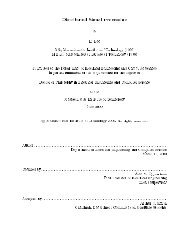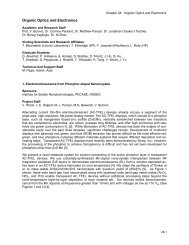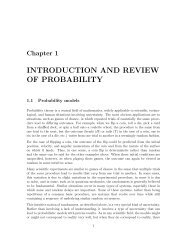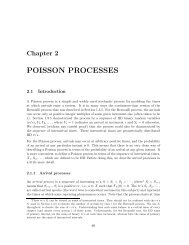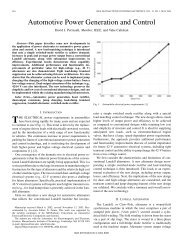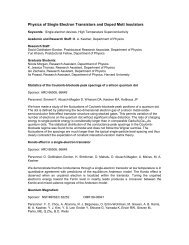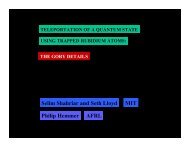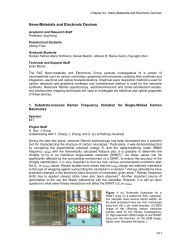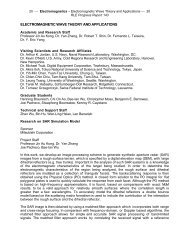A 24 Gb/s Software Programmable Analog Multi-Tone - Research ...
A 24 Gb/s Software Programmable Analog Multi-Tone - Research ...
A 24 Gb/s Software Programmable Analog Multi-Tone - Research ...
Create successful ePaper yourself
Turn your PDF publications into a flip-book with our unique Google optimized e-Paper software.
AMIRKHANY et al.: A <strong>24</strong> GB/S SOFTWARE PROGRAMMABLE ANALOG MULTI-TONE TRANSMITTER 1001<br />
Fig. 2. (a) Conceptual multi-tone system with low-pass filters and mixers at the transmitter and receiver to create band-limited sub-channels. X ; ...;X are<br />
input sequences. (b) AMT architecture with per-sub-channel linear N -times over-sampled equalizers at the transmitter, and mixer and integrate-and-dump at the<br />
receiver.<br />
replaced by -times 1 over-sampled equalizers per sub-channel<br />
[7]. An appropriate choice for the low-pass filter in the receiver<br />
that leads to superior performance and can be implemented<br />
reliably on chip is an integrate-and-dump circuit that integrates<br />
over one sub-channel symbol period [10]. Fig. 2(b) shows the<br />
finalized AMT architecture. In the architecture of Fig. 2(b),<br />
each -times over-sampled equalizer can shape the transmission<br />
bandwidth (from dc to the Nyquist frequency) of the entire<br />
system. Therefore, when all the sub-channel equalizers are<br />
optimized simultaneously, they work together to cancel both<br />
ISI and ICI at the same time.<br />
From a time-domain perspective, the AMT system is a transmultiplexer<br />
operating based on the principle of perfect reconstruction<br />
[11]. As an example, the time-domain waveforms of<br />
a 2-channel AMT system are plotted in Fig. 3(a) to illustrate<br />
this point further. In this example, the transmit equalizers are<br />
2-times over-sampled 2-tap filters, a zero-order hold filter performs<br />
discrete-to-analog conversion, the channel is assumed to<br />
be ideal, and there is no MIMO DFE in the receiver. Continuous<br />
time ISI and ICI patterns at the input to the samplers are<br />
also shown along with the sampled sequences and . It can<br />
be seen that even though the transmit equalizers are very short,<br />
and consequently, significant energy overlap exists between the<br />
1 N -times with respect to sub-channel symbol rate. Assuming all sub-channels<br />
are 2 PAM, each sub-channel equalizer is operating at the overall data rate<br />
of the link.<br />
two sub-channels at the transmitter output, both the ISI and the<br />
ICI are forced to zero at the sampling points at the receiver. As<br />
a result, and are fully recovered at the sampler outputs<br />
without any interference. However, the ISI and the ICI are not<br />
necessarily zero at points other than the sampling point. This is<br />
very similar to the operation of an equalized BB system where<br />
a linear equalizer forces the ISI to zero (only) at the sampling<br />
points.<br />
Ignoring the MIMO DFE, for large number of sub-channels,<br />
the AMT system shown in Fig. 2(b) is a very inefficient implementation<br />
of a DMT system in which the IFFT operation at<br />
the transmitter is performed using -times over-sampled equalizers.<br />
However, for a small number of sub-channels, the AMT<br />
system is highly efficient and its performance is not limited by<br />
cyclic prefix overhead [12]—a limiting factor in small-blocksize<br />
DMT systems. In fact, it can be shown that the equalization<br />
complexity (and consequently equalization power) of the AMT<br />
system is comparable to a BB system operating at the same<br />
overall throughput. To demonstrate this point further, Fig. 3(b)<br />
shows a 2-way parallelized 4-tap BB transmit equalizer and a<br />
4-tap-per-channel 2-channel AMT equalizer. The BB and AMT<br />
equalizers look structurally identical except that the taps in the<br />
lower branch of the 2-way parallelized BB equalizer are constrained<br />
to be a shifted version of the upper branch. The taps<br />
in the two branches of the AMT equalizer, on the other hand,<br />
have more degrees of freedom and can take values indepen-



